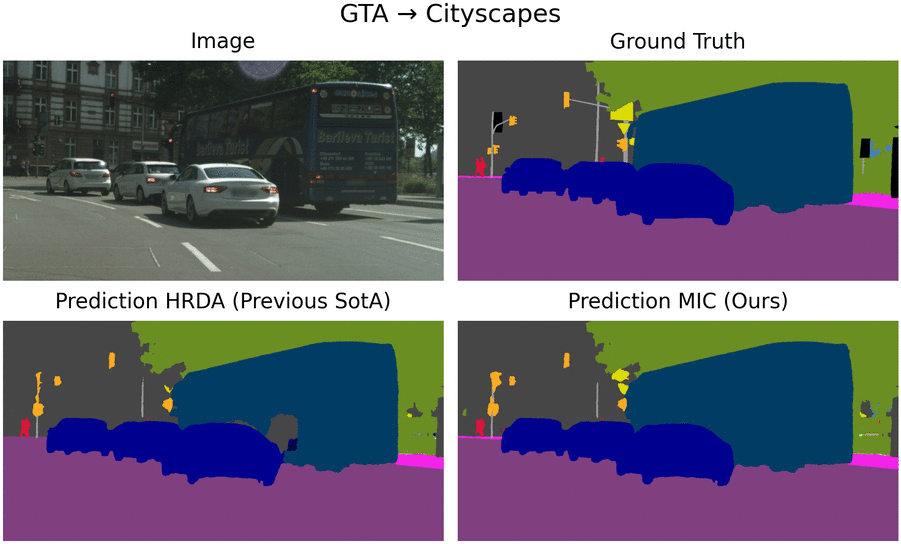by Lukas Hoyer, Dengxin Dai, Haoran Wang, and Luc Van Gool
🔔 News:
- [2024-07-03] We are happy to announce that our work SemiVL on semi-supervised semantic segmentation with vision-language guidance was accepted at ECCV24.
- [2024-07-03] We are happy to announce that our follow-up work DGInStyle on image diffusion for domain-generalizable semantic segmentation was accepted at ECCV24.
- [2023-09-26] We are happy to announce that our DAFormer/HRDA Extension on domain generalization and clear-to-adverse-weather UDA was accapted at PAMI.
- [2023-08-25] We are happy to announce that our work EDAPS on panoptic segmentation UDA was accepted at ICCV23.
- [2023-02-28] We are happy to announce that MIC was accepted at CVPR23.
In unsupervised domain adaptation (UDA), a model trained on source data (e.g. synthetic) is adapted to target data (e.g. real-world) without access to target annotation. Most previous UDA methods struggle with classes that have a similar visual appearance on the target domain as no ground truth is available to learn the slight appearance differences. To address this problem, we propose a Masked Image Consistency (MIC) module to enhance UDA by learning spatial context relations of the target domain as additional clues for robust visual recognition.
MIC enforces the consistency between predictions of masked target images, where random patches are withheld, and pseudo-labels that are generated based on the complete image by an exponential moving average teacher. To minimize the consistency loss, the network has to learn to infer the predictions of the masked regions from their context.
Due to its simple and universal concept, MIC can be integrated into various UDA methods across different visual recognition tasks such as image classification, semantic segmentation, and object detection. MIC significantly improves the state-of-the-art performance across the different recognition tasks for synthetic-to-real, day-to-nighttime, and clear-to-adverse-weather UDA. For instance, MIC achieves an unprecedented UDA performance of 75.9 mIoU and 92.8% on GTA→Cityscapes and VisDA-2017, respectively, which corresponds to an improvement of +2.1 and +3.0 percent points over the previous state of the art.
The improved domain adaptation performance is also reflected in the example predictions on GTA→Cityscapes, Cityscapes→ACDC, and Cityscapes→Foggy Cityscapes as shown below.
For more information on MIC, please check our [Paper].
If you find MIC useful in your research, please consider citing:
@InProceedings{hoyer2023mic,
title={{MIC}: Masked Image Consistency for Context-Enhanced Domain Adaptation},
author={Hoyer, Lukas and Dai, Dengxin and Wang, Haoran and Van Gool, Luc},
booktitle={Proceedings of the IEEE/CVF Conference on Computer Vision and Pattern Recognition (CVPR)},
year={2023}
}
You can find the source code to run MIC on domain-adaptive semantic segmentation in the subfolder seg/. For instructions how to set up the environment/datasets and how to train MIC for semantic segmentation UDA, please refer to seg/README.md.
We recommend starting with MIC for semantic segmentation as it implements the full set of configurations as well as the ablation studies.
You can find the source code to run MIC on domain-adaptive image classification in the subfolder cls/. For instructions how to set up the environment/datasets and how to train MIC for image classification UDA, please refer to cls/README.md.
You can find the source code to run MIC on domain-adaptive object detection in the subfolder det/. For instructions how to set up the environment/datasets and how to train MIC for object detection UDA, please refer to det/README.md.



